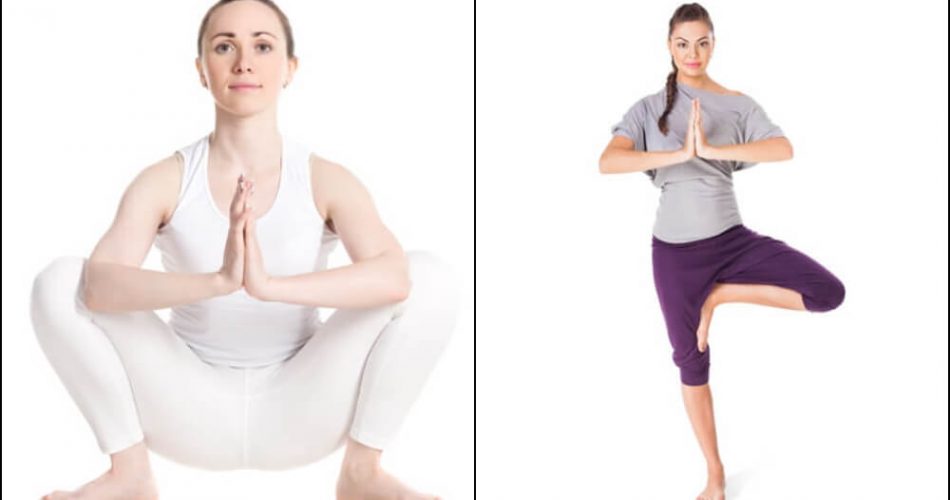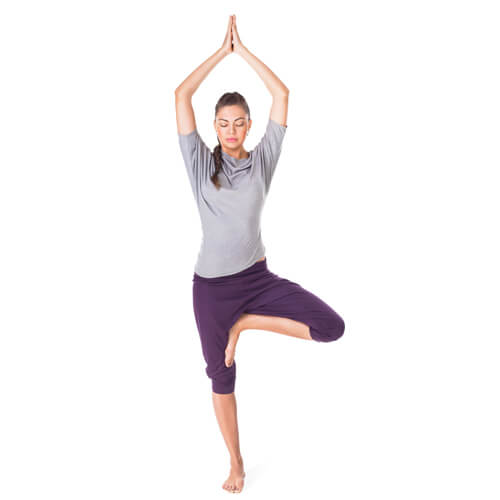Yoga is becoming increasingly popular globally, but some runners think they are not flexible enough to practice it. We’re here to tell you that anyone can do Yoga! This article explains how Yoga can be beneficial to both the body and mind. Since it doesn’t have any particular requirements, it has become a widely loved form of exercise, although it began in India around 5,000 years ago.
Let’s find out more about how Yoga can help runners in this article. Keep reading to learn how to add Yoga to your daily routine.
Why Are Yoga and Running a Great Combination?
Running and Yoga work together to help keep a balance of health and fitness. Running can cause tight muscles in the legs, which can lead to injuries, but doing Yoga exercises can help to prevent this. It also helps runners to know where their body is tight or unbalanced and helps them become more aware of their body.
Yoga is very helpful for runners, as it helps them with their mind-body connection. This allows them to control their breathing, focus and be mindful. These skills will help them stay in the best form while running and will help them to stay focused mentally even when running for a long time, which can improve their performance and endurance.
In addition, doing Yoga can help runners a lot in terms of mental health since they usually deal with mental exhaustion, worry, and tension. The meditative parts of Yoga can help with focus and calmness, giving them a break from their daily activities.
Exploring the Benefits of Yoga for Runners:
Here are the detailed physical advantages of adding Yoga to a runner’s schedule:
Improves Flexibility
Yoga can be very helpful for runners since it focuses on stretching and deepening poses. This can be especially helpful for people who get tight hamstrings, quads, or calf muscles from running. More flexibility can make running easier, with a longer stride, fewer muscle strains, and improved range of motion.
Enhances Balance
Yoga can help runners feel more balanced. Doing yoga poses that challenge your balance and stability can help you stay steady, reducing the chance of trips and stumbles. This improved balance will be especially useful for trail runners who run on uneven surfaces.
Increases Strength
Yoga involves exercising many muscles at once, like your abs, arms, and legs. Runners can gain more strength from this type of workout, which will help with their endurance, form, and posture. Having strong core muscles is important for good running technique.
Enhanced Breathing and Oxygen Utilization
Yoga teaches how to take deep breaths, which can help runners with oxygen usage and stamina. By practicing controlled breathing during yoga, runners can become better at controlling their breath while running.
Reduced Muscle Soreness
Runners can help prevent sore muscles after running and recover faster by stretching and doing yoga. Doing gentle yoga on days when they don’t run can help reduce muscle tightness and improve their general health.
Injury Rehabilitation
Yoga can be helpful for runners who are recovering from an injury. It helps them get stronger and more flexible again, but in a way that is gentle on the body.
5 Yoga Poses for Runners To Guide Better Performance
Below is a selection of Yoga poses especially helpful to runners. These are:
Cat-Cow
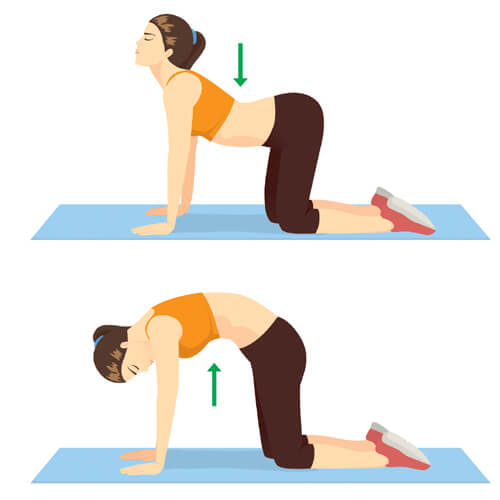
Image Credit: Shutterstock
How to Perform
- To get into a table-top position, place your hands and knees on the ground.
- As you breathe in, lift the crown of your head and tailbone, creating a slight backward bend.
- While exhaling, extend your tailbone towards the back of your knees and draw your chin towards your chest, simultaneously engaging your navel.
- Repeat this posture for around four to five times or for as long as you can manage.
Loaded Lunge
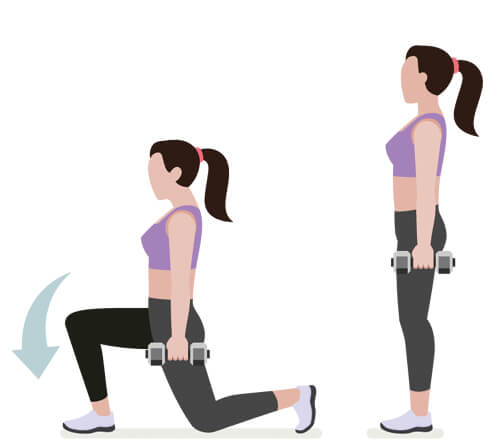
Image Credit: Shutterstock
How to Perform
- Ensure a distance of at least one foot between your feet, then take a step back with one leg, creating sufficient space.
- Flex your front leg, positioning the knee directly above your ankle.
- Engage your glute muscles by raising your heel high and extending through the front side of your hip.
- Create a diagonal line from your back heel to your shoulder by leaning your upper body forward.
- You can either bring your palms together in front of your chest or extend your arms overhead.
- Maintain this posture for 10 to 30 seconds, then repeat the same sequence on the opposite side.
Twisted Lunge
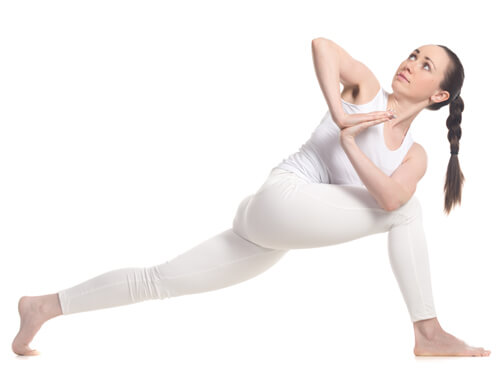
Image Credit: Shutterstock
How to Perform
- Begin by standing tall with your feet positioned hip-width apart.
- Step back with your right leg, landing on the ball of your foot, and ensuring it is about 2 to 3 feet behind your left foot.
- Lower your body into a lunge by bending your left knee. Keep your right foot’s heel lifted and your right leg straight.
- Rotate your upper body to the left, aligning your chest with your left thigh. Bring your palms together in front of your chest.
- Hold this twisted lunge position for approximately 20 to 30 seconds, or for a duration that feels comfortable to you.
- Slowly untwist your torso and return to the center. Push off with your left foot to stand tall again.
Tree Pose
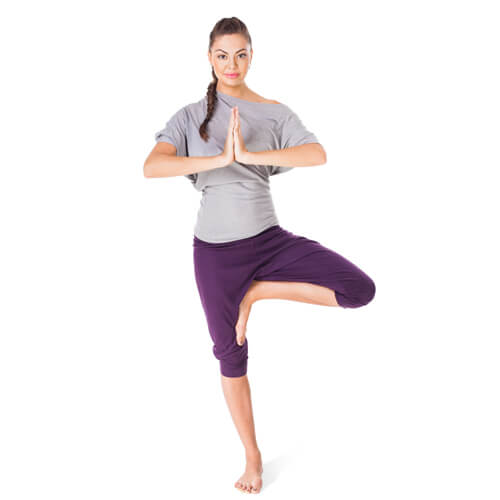
Image Credit: Shutterstock
How to Perform
- Maintain an upright posture with your feet positioned hip-width apart while focusing your gaze on a fixed point ahead for stability.
- Transfer your weight onto your right foot, ensuring a solid connection with the floor, and engage your core muscles to enhance stability.
- Position the sole of your left foot on the inner thigh of your right leg, with the left toes pointing downward and the heel pressing against the inner right thigh. If needed, you can place your foot on your right calf for a modified variation.
- Keep your hips level and maintain a neutral position for your pelvis as you find your equilibrium. Roll your shoulders back, lengthen your spine, and open your chest.
- You have the option to raise your palms overhead or bring your hands together in a prayer position.
- Hold this stance for approximately 20 to 30 seconds, or for a duration that feels comfortable to you.
Garland Pose
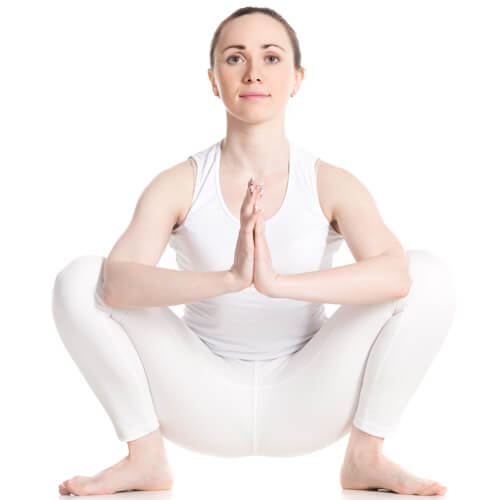
Image Credit: Shutterstock
How to Perform
- Begin by standing with your feet positioned hip-width apart, then gradually descend into a deep squat.
- Ensure that your feet remain flat on the ground or slightly turned out, depending on what feels most comfortable for you.
- Join your palms together in a prayer position at the center of your heart. As you do this, create room for your torso while gently pressing your knees apart with your elbows.
- Maintain an open chest and elongated spine. Keep your back straight to prevent any rounding, and slightly tuck your chin.
- Maintain this pose for approximately 20 to 30 seconds, or for a duration that feels comfortable to you.
Making a Yoga Program for Runners
Incorporating Yoga into a running program can be beneficial for the body as a whole. It can help to avoid injuries and improve performance. Here are some tips on how to make Yoga a part of your running routine.
1. Pre-Run Warm-Up Yoga Sequences
Before going for a jog, runners should do a few yoga exercises to get their bodies ready and reduce the risk of injury.
Sun Salutations – Surya Namaskar or Sun Salutations is a way of exercising your body by moving in certain poses. Doing this can help make your muscles stronger and make your body more flexible. It also helps your blood flow better.
Hip-Opening Poses – Runners should do poses like lunges and pigeons, as these help to loosen up tight muscles in the hips that can be caused by running. Doing these poses can help to prevent hip-related injuries and increase flexibility.
2. Post-Run Recovery Routines
It is important to help your body rest and heal after a run, and Yoga is the best way to relax and help your muscles recover.
Legs Up the Wall (Viparita Karani) – This posture helps to ease muscle pain and improve the blood flow in your legs, which helps them heal.
Child’s Pose (Balasana) – This stretch is meant to be gentle and is good for the lower back and hips. It can help reduce tension and help keep your thoughts peaceful.
Savasana (Corpse Pose) – This last pose helps you to let go of stress and bring your body back to its normal balance.
3. Rest Day Yoga Sessions
On days off or as a type of exercise, runners can do longer and different types of yoga to help increase their flexibility and strength.
Yin Yoga – Yin Yoga is a type of Yoga that involves slower stretches and postures that are held for a longer time. This practice helps to reduce the risk of getting hurt and is great for runners who want to become more flexible.
Strength-Building Poses – Runners can get stronger arms, core, and back by doing exercises such as Plank, Warrior II, and Chaturanga. This will help with their posture and help them run faster and better.
Mental Clarity and Stress Relief with Mindfulness and Breathing Techniques
Yoga and running require mindful and controlled breathing for better mental health, focus, and improved performance.
Mindfulness in Yoga and Running
Mindfulness in Yoga and running is about being aware of the current moment and of yourself. It means paying attention to the sensations in your body, your breath, and what is happening in your environment. It helps you become more self-aware, think more clearly, and be more in tune with your feelings. This can reduce stress and help you stay focused while running or competing.
Controlled Breathing in Yoga and Running
Breathing correctly is very important for both yoga and running. In yoga, breathing exercises (called pranayama) can help to control energy and relax your mind. For runners, breathing in time with their stride helps them to use oxygen better and reduces the chance of getting side stitches or feeling tired.
Appropriate Meditation and Pranayama Techniques for Runners
i) Meditation
Runners can get better at concentrating and being able to handle tough situations by adding mindful meditation to their training. This can be done through body scanning or sending love and kindness to others.
ii) Pranayama
Running can be improved by incorporating yoga into your routine. Doing so will increase your flexibility, reduce the risk of injuries, and increase your endurance. Anulom Vilom, or Alternate Nostril Breathing, is a breathing exercise that can help control breathing and increase lung capacity. All of these benefits can help make you a better runner, no matter your level of experience. Let us know if you found this article useful!
FAQs:
Q1. Are people who run, regardless of their skill level, able to do Yoga?
A. No matter if you are new to running or have been running for a while, Yoga can be a great addition to your workout routine. Doing Yoga can help improve your flexibility, strength, and focus, making it a great partner for running.
Q2. When is the best time to do Yoga while also running?
A. Many runners find that doing Yoga is beneficial both before and after running, although it may be different for each individual. Doing Yoga can also be helpful on days when you’re not running.
Q3. Can Yoga help stop injuries from running?
A. Yes! Doing yoga can help you stay safe while running by making your body more flexible, balanced, and strong. It can also help with common running issues like tight hamstrings or IT band problems and help you recover faster.
Read More:
